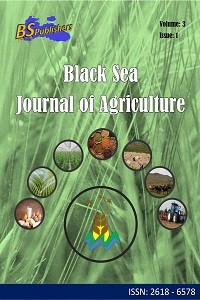Abstract
References
- Achoja FO, Okpara O. 2016. Mortality risk severity, associated factors and appropriate management options in poultry agribusiness in Delta state, Nigeria, Interl J Agric Exten Rural Develop Stud, 3(2): 1-14.
- Adewole SO. 2012. The efficacy of drugs in the treatment of coccidiosis in chicken in selected poultries. Acad Res Inter, 2: 20-24.
- Agriculture Victoria. 2008. Biosecurity guidelines for poultry producers, No AG1155. agriculture.vic.gov.au/agriculture/pests-diseases-and-weeds/animal-diseases/poultry/biosecurity-guidelines-for-poultry-producers (accessed date: October, 01, 2019).
- Akintunde OK, Adeoti AI, Okoruwa VO, Omonona BT, Abu AO. 2015. Effect of Disease Management on profitability of Chicken Egg Production in South West Nigeria. Asian J Poult Sci, 9: 1-18.
- Alalade OA, Olorunfemi OD, Olaoye IJ, Ladipo TO, Yusuf A. 2018. Assessment of factors influencing biosecurity measures employed by livestock farmers in selected LGA of Kwara State, Nigeria. J Sci Technol Math Edu, 14(2): 90 -100.
- Ali MM, Hossain MM. 2012. Problems and prospects of poultry-based food producers in Bangladesh: An Analysis: AIUB Bus. Economics Working Paper. Series 2012-01.
- Dorea FC, Berghaus R, Hofacra C, Cole DJ. 2010. Survey of biosecurity protocols and practice adopted by growers on commercial poultry farms in Georgie, USA. Avian Dis, 54: 1007-1015.
- Koblentz GD. 2010. From Bio-defence to Bio-security: The Obama administration’s strategy for counting biological threats. Inter Affairs, 88(1).
- Olagunju FI, Babatunde RO. 2011. Impact of credit on poultry-based food producers productivity in South/West Nigeria, APRN, J Agri Biol Sci, 6(10).
Abstract
Cost of preventing disease incursion and containment in poultry management is gaining attention in scientific and public debates. Biosecurity involves the use of relevant resources to secure poultry-based food production system (products, producers and consumers health) from diseases. This study investigates whether biosecurity resources are efficiently utilized to enhance maximum profit in poultry-based food production. Primary data used for the study were obtained from 120 sampled poultry farms. Multi-stage procedure was adopted in the selection of the sampled farms. Structured questionnaire was the data collection instrument used for the investigation. Descriptive and inferential statistical tools were employed in data analysis. Also cost efficiency model and profit functions were usedto analyze data. The result shows that bio-secured poultry farms had a mean profit of N 150,230 higher than N 92,590 earned by bio-insecured farms. Profitability of biosecured poultry farms significantly and positively correlated (2.02)** with bio-security management index (p<0.05). The major constraints to bio-security management of poultry farms were high cost of effective disinfectant/vaccines and unwillingness of farmers to adopt effective biosecurity management practices. The researcher has sufficient reasons to conclude that biosecurity resources were efficiently utilized, hence the relative high profit that was realized. However, the biosecurity management index gap of 37.5% observed in the study suggests that there is still room for improvement.
References
- Achoja FO, Okpara O. 2016. Mortality risk severity, associated factors and appropriate management options in poultry agribusiness in Delta state, Nigeria, Interl J Agric Exten Rural Develop Stud, 3(2): 1-14.
- Adewole SO. 2012. The efficacy of drugs in the treatment of coccidiosis in chicken in selected poultries. Acad Res Inter, 2: 20-24.
- Agriculture Victoria. 2008. Biosecurity guidelines for poultry producers, No AG1155. agriculture.vic.gov.au/agriculture/pests-diseases-and-weeds/animal-diseases/poultry/biosecurity-guidelines-for-poultry-producers (accessed date: October, 01, 2019).
- Akintunde OK, Adeoti AI, Okoruwa VO, Omonona BT, Abu AO. 2015. Effect of Disease Management on profitability of Chicken Egg Production in South West Nigeria. Asian J Poult Sci, 9: 1-18.
- Alalade OA, Olorunfemi OD, Olaoye IJ, Ladipo TO, Yusuf A. 2018. Assessment of factors influencing biosecurity measures employed by livestock farmers in selected LGA of Kwara State, Nigeria. J Sci Technol Math Edu, 14(2): 90 -100.
- Ali MM, Hossain MM. 2012. Problems and prospects of poultry-based food producers in Bangladesh: An Analysis: AIUB Bus. Economics Working Paper. Series 2012-01.
- Dorea FC, Berghaus R, Hofacra C, Cole DJ. 2010. Survey of biosecurity protocols and practice adopted by growers on commercial poultry farms in Georgie, USA. Avian Dis, 54: 1007-1015.
- Koblentz GD. 2010. From Bio-defence to Bio-security: The Obama administration’s strategy for counting biological threats. Inter Affairs, 88(1).
- Olagunju FI, Babatunde RO. 2011. Impact of credit on poultry-based food producers productivity in South/West Nigeria, APRN, J Agri Biol Sci, 6(10).
Details
| Primary Language | English |
|---|---|
| Subjects | Food Engineering |
| Journal Section | Research Articles |
| Authors | |
| Publication Date | January 1, 2020 |
| Submission Date | October 2, 2019 |
| Acceptance Date | November 21, 2019 |
| Published in Issue | Year 2020 Volume: 3 Issue: 1 |


